A Better Trail to New Rail and Parkland in Queens

QueensLink rendering
The Rockaway Beach Branch right-of-way is a 3.5-mile, skinny strip of land that holds the key to transforming our borough in two fundamental ways. First, it will connect north and south Queens with the rest of the city in an environmentally sustainable way. Second, it will create up to 33 new acres of park space adding value to local neighborhoods and the entire city.
This dual-purpose project is called QueensLink.
It was disappointing to read “A Greenway for Queens” (December 5), where the authors continue to deny the need for better transportation. While the Manhattan-based Trust for Public Land apparently believes Queens doesn’t need more transit, riders and residents, who face some of the longest commutes in the nation, would disagree.
The QueensLink would bring travel time from Howard Beach to Midtown Manhattan down from over an hour to 45 minutes as well as create faster trips throughout the borough and to Brooklyn.
The authors repeat the myth that new transit and new parks can’t be built along this corridor, but this belies the simple fact that in most other places using land for both uses is common. In Oakland, CA, the BART system was built along an old freight rail line that was converted to rapid transit with land at ground level used for a parkway. Miami, Vancouver, Boston, and Atlanta have all incorporated parks along their transit lines. QueensLink would create up to 33 acres of new park space connecting north and south Queens.
Queens has 2.3 million inhabitants but the fewest subway miles per resident of the four boroughs with subway access. Roads like Woodhaven Boulevard. and Van Wyck Expressway are constantly congested while buses are overcrowded and average just 8–10 mph. Subways are the fastest, cleanest, and most efficient way to move many people great distances.
While adding a modest 3.5 miles to the system, the value is most apparent in the connections the QueensLink offers. Finally, riders could get from north to south Queens on one train without having to ride through Manhattan and Brooklyn. Brooklyn riders could access jobs in Queens more easily. The QueensLink would connect to every east-west transit line in Queens to offer the most options for commuters.
The status quo of pitting two sides against one another so nothing is ever done has to end. At this critical juncture in our borough’s history we need individuals and organizations that will rise above the NIMBYism of the last generation. We need thought leaders and elected officials with vision and the courage to advocate for projects that achieve the greater good rather than continue to protect the narrow interests of the well-heeled and well-connected few.
When you have a valuable public asset like the Rockaway Beach Branch right-of-way it is crucially important to analyze what use or uses represent the greatest public good. We have one shot at getting this right, so let’s take an objective look at that question and see where the facts lead us.
The MTA released its long-delayed Rockaway Beach Branch reactivation study last month and the conclusions were gratifying. The MTA determined that reactivating the line as a subway from Queens Blvd., Rego Park to Howard Beach, JFK Airport was feasible. The study also determined that 47,000 riders a day would use the line, a conservative figure since it does not include connecting passengers.
Much of the extra costs included by the MTA were due to their extended projected construction schedule of ten years that should take no more than two to three. While the total MTA number associated with the project was $8 billion, the hard construction costs are about $1.6 billion. Experts have estimated that a design-build approach should result in a total cost of about $2 billion. Still a formidable number but a more realistic one.
Even with lower costs, building the rail and park will require thinking outside the box. QueensLink is developing a new funding strategy that incorporates transit-oriented development and value capture through a public-private partnership.
QueensLink takes inspiration from the LIRR Third Track, a large rail infrastructure project that, like the Rockaway Beach Branch, was bogged down by small thinking for decades. Now this $2.6 billion, 9.5-mile project is underway and on-time and on-budget. Local communities along the rail played a big part in the planning and design, which ultimately led to its success.
QueensLink represents an investment in transit equity that will help people reach education, employment, and recreational opportunities that were out-of-reach before. It is also fully aligned with city and state environmental initiatives to reduce congestion on our roads and the carbon emissions that come with it.
Queens is now at the crossroads. The borough’s residents and elected officials will soon have to decide if we will rise to the challenge of working together for our common good or against each other to our common detriment. The good news is that we don’t have to decide between a rail and more green space, a well-designed QueensLink can and should provide both.
***
Rick Horan is the Executive Director of QueensLink and Andrew Lynch is the Chief Design Officer. On Twitter @thequeenslink.
***
Have an op-ed idea or submission for Gotham Gazette? Email This email address is being protected from spambots. You need JavaScript enabled to view it.
Two Troubling Trends Collide in City Homeless Outsourcing
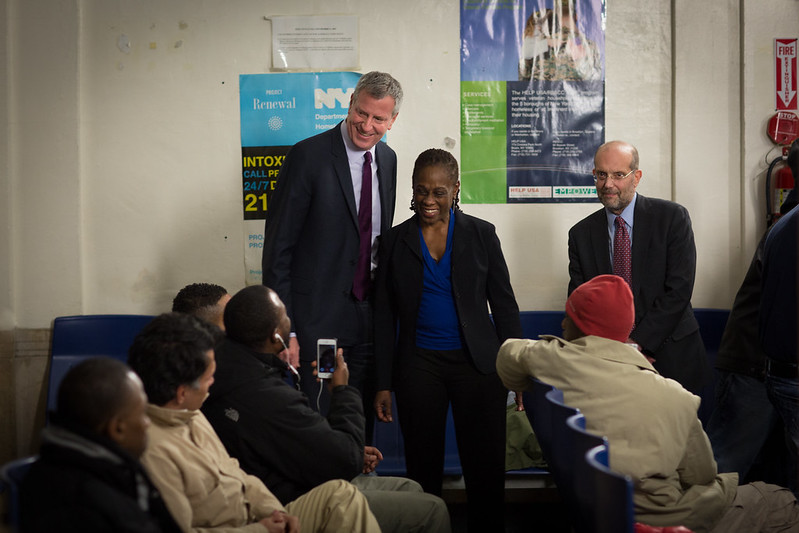
(photo: Michael Appleton/Mayor's Office)
Last week the City of Newark sued New York City over New York’s placement of more than a thousand homeless individuals and families in Newark, through the city’s Special One Time Assistance (SOTA) program. Under the program, New York City employed private brokers to find homes for the families in New Jersey and elsewhere, and, without checking to see if the homes were habitable, paid a full year’s rent in advance and left families to live there. The result was thousands of families sent out of the city into homes that were uninhabitable.
The Newark lawsuit, which details instances of lack of heat and vermin infestations, sought to prevent New York from “coercively relocating” any future families via the SOTA program. Newark’s brief goes on to object to New York’s “ill-conceived, surreptitious efforts to shift the burdens associated with the homeless to other communities in this nation.” In court on Monday, New York agreed to a temporary halt to the program in Newark, but the lawsuit continues.
The SOTA program represents the culmination and convergence of two particularly disturbing recent trends: New York’s failure to provide safe housing for homeless people and New York’s propensity to outsource social services without proper oversight.
As to the first trend, New York City’s recent history in providing unsafe housing for homeless people is distressing. During our time running New York City’s Department of Investigation we did two Reports outlining the deplorable conditions at New York City shelters. Those Reports detailed fire and safety hazards, dead vermin in bedrooms, widespread prostitution activity, and a lack of essential services.
The second, equally disturbing trend, is New York’s continued outsourcing of government programs without proper oversight. While at DOI we witnessed the tendency of New York City agencies to hire private vendors to provide essential services yet fail to: one, set standards for the work to be done; two, supervise the agencies; and three, take action against contractors who neglected to carry out their requisite functions.
For example, one DOI investigation found that while the city’s Administration for Children’s Services hired private providers to carry out certain ACS functions, ACS failed to take action even after learning that some of these providers were not performing up to standards and were putting children in harm’s way. Indeed, ACS continued to pay these providers for dangerously inadequate care.
Similarly, for years, the City’s Department of Correction hired a private company, Corizon Health, to provide health care services to inmates in city jails. Corizon neglected to screen and manage staff, creating a series of dangers without effective oversight from the city. A report from DOI that exposed the problem finally forced the city to remove Corizon.
City government’s mishandling of SOTA combines both trends with the worst possible outcomes. Not only did the city outsource its problem – hiring private brokers to find apartments – but by sending the families to other jurisdictions, and refusing to provide those jurisdictions with the identities and locations of the families, they made oversight impossible.
In theory, getting homeless families housing in New Jersey, where rents are cheaper, is not inherently wrong (regardless of whether the motivation is to get families off New York City’s rolls or some other greater good). But doing this without checking to make sure the housing is habitable and refusing to tell the New Jersey localities who has been placed in their jurisdiction, is unacceptable. Only the filing of a lawsuit forced New York to provide Newark with information on the families’ locations.
This goes beyond a failure to set standards and supervise outside contractors. Here, when New York sent these families to Newark and paid the private landlords for a year in advance, New York gave up the ability to have its own agencies make sure the housing was habitable and it failed to give New Jersey that opportunity. The end result was that New York had less money -- having sent it to landlords who provided deplorable housing -- and Newark, not aware of where the placements were, was unable to fix the problem.
Going forward, if New York is to continue sending homeless families out of state – and, it appears that it plans to do so – at a minimum the city must properly check the habitability of all dwellings, stop paying for a full year in advance, and coordinate with the other jurisdictions, providing them full information and cooperation. Anything less is not an anti-homelessness program but a dumping of responsibilities.
***
Peters and Brovner are the founding partners of the law firm Peters Brovner LLP and were, respectively, the Commissioner and First Deputy Commissioner of the New York City Department of Investigation from 2014 to 2018.
***
Have an op-ed idea or submission for Gotham Gazette? Email This email address is being protected from spambots. You need JavaScript enabled to view it.
For Future Generations, New York City and State Must Significantly Increase CUNY Investment Now
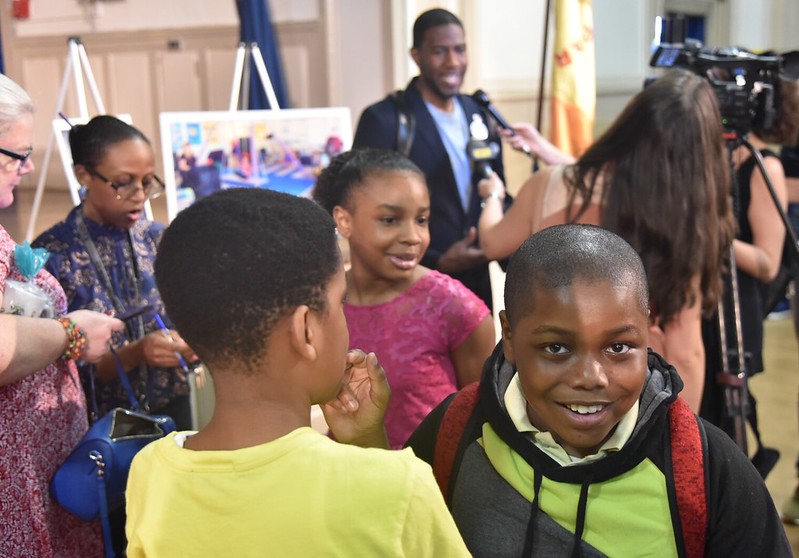
(photo: John McCarten/City Council)
I’m a CUNY graduate twice over – my bachelor’s and master’s degrees are both from Brooklyn College. Between the seven years I took for my four-year degree, and the four years for my two-year degree, I’ve spent about as much time on a CUNY campus as anyone. My professors, my fellow students, my overall CUNY experience shaped who I am and what my driving principles are -- what I’ve been fighting for as an activist and an elected official.
Now, as tuition rises and investment stagnates, I fear that students across our city will be denied that transformative, invaluable, CUNY experience.
As outlined in my recent report, government funding for CUNY has failed to keep up with booming enrollment. From 2008 to 2017, per-student funding from the state dropped 18 percent, adjusted for inflation and enrollment growth. This continued underfunding has hamstrung CUNY’s ability to provide a quality education for thousands of students, most of whom are people or more color and graduated from our city’s public schools.
In fact, the student body of CUNY appears directly related to its funding. When CUNY was first established, it was tuition-free, in recognition of the need for accessible, high-quality public education. But as the complexion of CUNY students changed, so too did the policy, with black and brown student majorities made to bear the brunt of the expense as the balance of funding CUNY shifted away from government and toward the student population. This has naturally also contributed to the overall challenges of financing this “public” education.
With limited resources, CUNY has seen its operational quality threatened as the system has to rely on underpaid adjunct faculty to teach its students, many of whom work additional jobs to pay their bills. CUNY has also been forced to cut student support services—like academic and mental health advisors or hours at writing centers—and course selections, leaving many students unable to register for a mandatory class.
Financial shortcomings are also evident in CUNY’s physical infrastructure—broken toilets, exposed wiring, vermin outbreaks, flooding, and broken elevators further detract from the educational experience of today’s students.
Unfortunately, the students who suffer the most from underfunding are those who most need our help. CUNY’s constrained budget provides limited opportunity for it to help support its most vulnerable students, many of whom are food insecure, homeless, or come from low-income families. While tuition remains comparatively low, CUNY students who receive tuition assistance still must pay for major expenses like housing and food, forcing them to work for pay and spend more time away from their studies. Without proper support, CUNY students are finding it hard to graduate.
However, there’s a silver lining: CUNY knows what works and just needs the resources to do it.
CUNY has created innovative programming, like ACE and ASAP, which have already boosted graduation rates and improved educational outcomes. Other programs aimed at providing support for specific marginalized communities, including the Black Male Initiative and Citizenship! Now, help campuses retain and support students of more color, who make up the majority of CUNY’s population.
These programs and others are part of why CUNY campuses are among the best nationwide for raising the economic statuses of the system’s most vulnerable students—a pathway and an opportunity for lower- and middle-class students of all racial and ethnic backgrounds. It’s also critical to know when something doesn’t work, like the Excelsior Scholarship, which made headlines but not real change, as nowhere near enough students saw relief from ever-escalating costs of a college education.
To ensure CUNY can support its mission of serving as a vehicle of social mobility that provides quality education for all New Yorkers, New York State and New York City must increase investment in public higher education. Crucially, the city must specifically increase its funding for CUNY senior colleges, which have historically received limited city funding, to better match their contribution to our city’s economy and culture.
This month, CUNY’s staff and faculty union, the Professional Staff Congress (PSC), ratified a new contract that secured historic gains for nearly 30,000 workers. But any discussion of increasing wages must be coupled with calls to address the underlying issue: the need for New York to increase its financial commitment to public higher education.
Our state and city leaders are now at a critical juncture. They can either decide to build on their investment in higher ed and ensure students receive a quality affordable education, or allow an invaluable, historic educational institution to decline, along with the opportunities it creates.
With greater funding, CUNY will be able to increase the percentage of its faculty that works full-time and raise salaries for remaining adjuncts. It can also expand its student tuition-assistance programs to include more part-time students and even currently incarcerated individuals. And it can continue to build on its world-class programming, providing an invaluable education for generations of New Yorkers like it did for me and so many others already.
***
Jumaane Williams is the Public Advocate of the City of New York. On Twitter @JumaaneWilliams.
***
Have an op-ed idea or submission for Gotham Gazette? Email This email address is being protected from spambots. You need JavaScript enabled to view it.
The Energy Behind the Renewable Rikers Vision
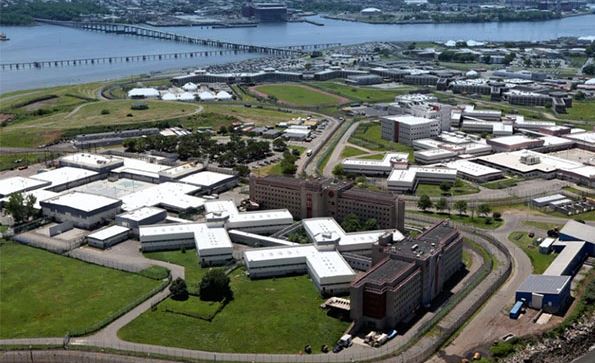
Rikers Island (photo via Lippman Commission report)
After five years of struggle, the New York City Council voted last month to finally shutter the house of horrors that is Rikers Island. Closing this facility, however, is only the first step toward true restorative justice. New York City must invest in the communities that have borne the brunt of the over-policing and under-investment that fueled the mass incarceration machine. These communities are the same ones who are most vulnerable to rising sea levels, toxic air, and extreme heat brought about by the climate crisis.
The good news is that a group of advocates, experts, community organizations, and Council members has proposed a solution to solving all of these challenges with one sound policy: a Renewable Rikers Island.
Our collaboration created a framework for the Renewable Rikers Act, a three-bill package that sets us down a road to restorative justice. The plan would mean fewer trucks, cleaner air, less waste, lower asthma rates, and new access to waterfront and affordable housing on the footprint of former pollution factories.
The Lippman Commission on the closure of the Rikers jails, the #CloseRikers coalition, and the City Council’s Progressive Caucus have all endorsed this as the best plan moving forward.
We can use part of what will be newly-available 413 acres to build a solar farm, with space for large-scale batteries to store the energy generated. With plenty of land left over, the city can build a state-of-the-art wastewater treatment plant on Rikers to absorb much of the sewage overflow that currently pollutes our waterways, particularly adjacent to low-income and working communities. If the ambitious vision is implemented, this new waste water treatment plant could mean shutting down one or more of the Depression-era wastewater treatment plants in communities overrun with polluting facilities.
A new treatment plant on Rikers should also be outfitted with an anaerobic digester, which turns the facility’s sludge into natural gas. This digester can also process food waste that currently goes to a landfill, where it emits greenhouse gases. Expanding organic waste processing on Rikers means it will no longer be trucked in and out of the South Bronx, North Brooklyn, Southeast Queens, and Sunset Park, where most waste transfer stations are clustered.
Even if we make only some of this happen on Rikers Island, it would open up land in communities of color that have been disproportionately impacted by the criminal justice system. The Regional Plan Association expects more than 200 acres of city-owned land to become available for public use if we build wastewater plants on Rikers. Closing “peaker” plants – the plants that only kick on during times of high power demand – across the five boroughs will open up sizeable footprints in communities of color that have long pined for new parks, community centers, and affordable housing, while also reducing the air pollution emitted by these fossil-fuel burning plants.
And finally, a Renewable Rikers will create thousands of good, green jobs in innovative industries. Those should be filled primarily by the formerly incarcerated who have turned their lives around, as well as members of communities who for too long saw little investments in their neighborhoods.
We can only have real environmental justice if the stakeholders in these neighborhoods are the ones who drive the conversation around how this land is used. The time to listen to their voices is now.
Detractors and distractors will try to point to other possibilities for Rikers Island, but we believe that is simply an attempt to kick the can down the road. Justice delayed is justice denied. Any proposal that does not directly benefit the communities so long impacted by the abhorrent conditions in the jails on Rikers should not be considered as a matter of process and justice. And, this land is unsuitable for anything else because it is built on a decaying toxic landfill.
The coalition of criminal justice reform, community, environmental, faith-based, and environmental justice organizations and advocacy groups who support the Renewable Rikers vision is diverse and vast. This is a clear opportunity for our city to continue taking bold and progressive steps towards a more sustainable and just future, and passing the Renewable Rikers Act is the first critical measure to ensure we move toward this vision of a cleaner, greener, fairer city.
***
City Council Member Costa Constantinides represents parts of Queens and Rikers Island, and chairs the Council’s Committee on Environmental Protection; he’s on Twitter @Costa4NY. Melissa Iachan, Esq., is a Senior Staff Attorney in the Environmental Justice Program at New York Lawyers for the Public Interest.
***
Have an op-ed idea or submission for Gotham Gazette? Email This email address is being protected from spambots. You need JavaScript enabled to view it.
At the Bedford-Union Armory, a Community’s Vision is Realized

Beford-Union Armory rendering
As one of Brooklyn’s most historic neighborhoods, Crown Heights is a cultural landmark and epicenter for creativity. For many that knew Brooklyn before the age of mega-development, Crown Heights was once home to many recreational spaces for youth and families. I remember growing up in the Crown Heights/East Flatbush section of Brooklyn with a variety of recreational outlets, from the Empire Roller Rink and Bedford Bowl to the Kenmore Movie Theatre to the Crown Heights Youth Collective and more. I always felt like I had somewhere to go.
From 2007 onward, the Crown Heights community has felt the impact of the absence of recreational spaces for young people, left without vital community resources to help navigate young adulthood. For over a decade, our youth have grown up without essential academic and recreational spaces to live, learn, and grow. Today we celebrate the symbolic resurgence of community in Crown Heights with the groundbreaking for the newly renovated Bedford-Union Armory.
Steeped in tradition and legacy, yet newly designed to meet the needs of all residents, this space will cultivate a new era for Crown Heights: restoring unity in the community.
For generations, activists and community organizers have argued that the community needs a vibrant recreational center to be utilized by all residents, and reflect the rich history of the neighborhood. As Central Brooklyn continues to change, it is becoming increasingly more difficult for cultural non-profits to find permanent, affordable spaces to flourish and grow within the community.
As of next year, the repurposed armory will serve as a multi-use facility with affordable housing, recreational space, arts, after-school programming, and more. This week’s groundbreaking is the first step toward realizing the vision that has united our community.
Currently under construction, the Bedford-Union Armory’s vast recreational space will include three hardwood basketball courts, a multi-sport field, and a six-lane swimming pool—all of which will be available to local families and students at nearby schools. When standing inside the armory, it does not take much imagination to envision a completed athletic facility bustling with the energy and excitement of students unwinding after a long day at school. Rooted in the Crown Heights community tradition, the armory builds on the forward-thinking vision of Congressional Rep. Major Owens and other community stakeholders envisioned by creating a neighborhood hub for activity.
Partnerships with groups like New Heights Youth will help empower local students to reach their full academic and personal potential. This organization, which will be housed in the classroom space of the new armory, works with young men and women with an interest in basketball. Their after-school program in Crown Heights will help students to complete their homework before hitting the courts. Since 2005, 100 percent of New Heights students have graduated high school, and 98 percent enroll in college.
With programming that bridges education, arts, athletics, and empowerment, we know that the armory will be a long-standing community center in our beloved neighborhood.
While the Armory’s recreation center will be a community gathering space, it is these non-profit tenants that prove most exciting. Many of those tenants, leasing space at $6 a square foot, are providing programming and services that will truly make a difference with Central Brooklyn’s youth.
Consider, for example, Ifetayo Cultural Arts Academy, the organization that provides African-centered rites of passage programming to over 2,000 students and their families, will take up a permanent space at the Bedford-Union Armory. It will expand to a seven-day-per-week program offering academic support and mentoring in addition to dance classes.
A similar story will unfold with Digital Girl Inc. The organization, which offers computer classes and other services for young women and men, now spends time in public schools, but also lacks a permanent home. When the armory opens its doors, it will have a complete computer lab that will operate seven days a week, making STEM programming the new norm, not an academic luxury for the elite.
There is so much more that could be said about the armory’s impact: over 29 nonprofits and athletic organizations will call it home when it is finished, plus the additional educational and enrichment programs that will utilize the common space and recreational activity. Each of these organizations are already impacting the community and now their efforts will be supported and amplified by the armory’s resources.
All in all, the redeveloped Bedford-Union Armory will offer services to the entire Crown Heights community with the recreation, performing arts, and after-school programming that it has deserved for generations. This week’s groundbreaking is merely the first step forward in this historic project of which all Central-Brooklynites can be proud.
***
City Council Member Laurie Cumbo represents parts of Brooklyn and is the majority leader of the Council. On Twitter @CMLaurieCumbo.
***
Have an op-ed idea or submission for Gotham Gazette? Email This email address is being protected from spambots. You need JavaScript enabled to view it.
Toward a Binary Free NYC
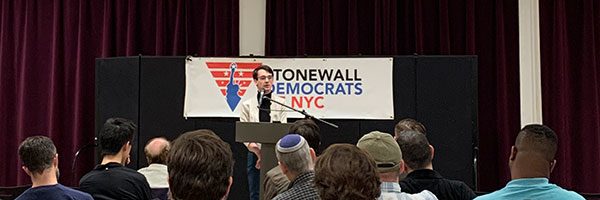
Emilia Decaudin, the author
For nearly 100 years, Democrats in the State of New York have elected one man and one woman per Assembly District to serve in the Democratic Party’s governing body, the State Committee. A rule change passed last month means that after 2020, this will no longer be the case.
Eleanor Roosevelt and the League of Women Voters pushed for gendered seats for party offices, which include State Committee, District Leader, and County Committee, in order to promote the participation of women in politics. In 2019, however, these rules mean that non-binary people—those who don’t identify as being exclusively either women or men—are, in most cases, barred from running for party office.
In order to solve this problem, I authored a resolution that passed at last month’s State Committee meeting that amends the rules of the New York Democratic Party in three important ways:
First, language that required two corresponding party officers, such as Secretary and Assistant Secretary, to be of “the opposite gender” has been changed to require they be of “different genders,” or both non-binary.
Second, language requiring gender “balance” on committee has been changed to not require members to identify as either women or men, while maintaining an equal number of the former.
Third, beginning on July 1, 2020, instead of electing “one male and one female” per Assembly District, Democrats will elect people of “different genders,” or who are both non-binary.
The resolution also adds gender and gender identity to the Party’s diversity clause and replaces gendered pronouns, such as “he or she,” with the singular “they.”
These changes will open up participation in the State Committee to a growing class of New Yorkers, while keeping in place the fundamental requirement for gender diversity that ensures that men don’t dominate party committees at the expense of women.
While this is important progress, this particular resolution only applies to the State Committee, which has no authority over the 62 County Committees in New York State. Many of those, including Brooklyn and Queens, have gendered County Committee seats, and all of them in New York City have gendered District Leader seats. These positions are arguably more important for the goal of inclusion, as most people break into the political party scene at the County Committee level.
Efforts are already underway in Manhattan and Brooklyn to remove gender requirements for District Leader and County Committee, respectively. (Manhattan doesn’t have gendered county committee seats, and Brooklyn District Leaders are coterminous with State Committee members.)
The first election for State Committee members under these new requirements will be in June of 2022. Before then, State Election Law must be changed in order to accommodate this new system. This is why I have also written a piece of legislation, sponsored by Assembly Member Richard Gottfried of Manhattan, who also sponsored the Gender Expression and Non-Discrimination Act (GENDA), in order to amend the way the Board of Elections handles elections for party positions to do just that.
The bill, which is slated to be introduced next session in Albany, changes the way all party positions for all political parties appear on the ballot. If a party has two vacancies for an office with gender requirements, instead of voting for one person in the male column and one person in the female column, voters will vote for two people in one column. Whoever gets the most votes wins one seat outright. Whoever gets the next most votes and is of the “opposite” gender or is of a different gender than the first candidate (depending on that party’s rules) also gets seated.
All of these granular changes to the way we elect candidates for party offices may seem insignificant at first. But they serve the important function of opening the door to participation by non-binary people preemptively and proactively, rather than waiting for them to knock on the door loudly and long enough for us to begrudgingly turn the lock.
Even then, there is more work to be done. Binary language that either formally or implicitly excludes non-binary people can be found in a myriad of places in our city—laws, regulations, press releases, signage, forms, and more. To tackle this issue, I’ve started Binary-Free NYC, which will serve as an umbrella for both the work being done at the party committee level and in other public forums. With any luck, New York State will continue to be a leader on gender diversity and inclusion.
****
Emilia Decaudin is a student and activist in New York City. She is the youngest and first openly transgender member of the New York State Democratic Committee, representing the 94th Assembly District in Westchester County. On Twitter @e_decaudin.
***
Have an op-ed idea or submission for Gotham Gazette? Email This email address is being protected from spambots. You need JavaScript enabled to view it.
Truly Equipping New York City to End Mass Incarceration and Close Rikers
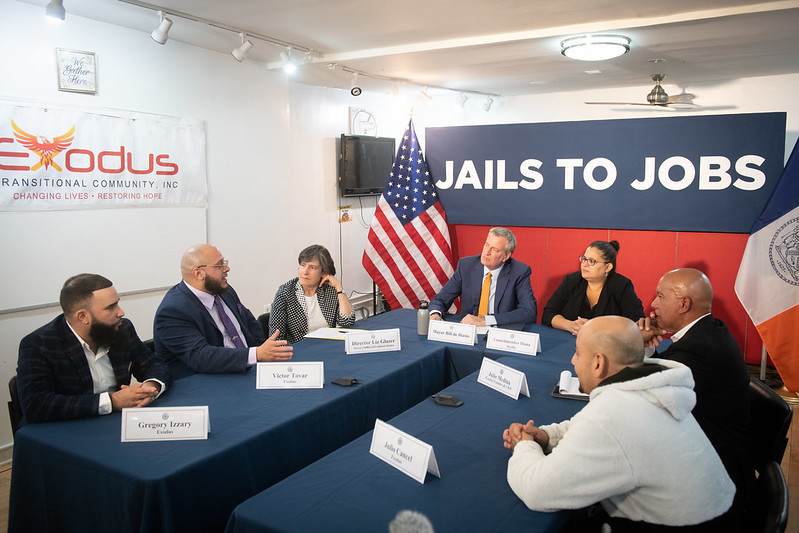
(photo: Michael Appleton/Mayor's Office)
For decades, formerly and currently incarcerated New Yorkers -- along with mental health experts, legal advocates, and service providers -- have demanded that city officials find the courage to close Rikers Island jails once and for all, erasing a shameful stain on the legacy of a city that aspires to be the most progressive in the world. Due in part to the sweeping success of the #FREEnewyork campaign securing transformative pretrial reforms in Albany this year, New York City is on track to release over 900 New Yorkers from city jails ahead of a January deadline -- bringing us that much closer to shutting down Rikers, permanently.
In the past several months, we have seen fear-mongering opponents of criminal justice reform continue to spread myths about threats to public safety and the excessive costs of implementing these reforms, while advocates have not stopped fighting to uplift living examples of a better future.
In November 2018, RFK Human Rights Foundation launched the “Mass Bail Out” in collaboration with JustLeadershipUSA, VOCAL-NY, katal, and other grassroots advocacy organizations. This bail out operation lasted roughly one month and successfully freed 107 women and children from New York City jails. A major component of the bail out was the welcome center/resource tent that provided folks with information on housing and legal resources, a fresh toothbrush, a MetroCard, and a prepaid cellphone, among other things to ensure people had support when returning home.
Of the 107 people who were freed, 105 returned to their next court date— and these results are not unprecedented. Actions such as the nationwide Mama’s Day Bailout have produced incredible results that prove time and time again what impacted communities and organizers already know: capital and cages are not the best way to ensure return to court. Resources and support are.
On October 17, the New York City Council held a historic vote on the future of Rikers Island. This vote, and the organizing that influenced the Council to improve upon the mayor’s proposed plan, was passed alongside upwards of $260 million of investments into community-based solutions and resources outside of the justice system.
Since the #CLOSErikers campaign launched in 2016, advocates have made clear that many successful alternative responses to crime and punishment already exist in communities -- in New York and across the world -- but our city, state, and federal budgets have historically undervalued and under-utilized these practices in favor of expanding punitive responses and the carceral system.
The leaders of the #CLOSErikers campaign never lost sight of their broad vision to permanently shrink the jail system; improve conditions for anyone who remains incarcerated; and decarcerate through both legislative reforms and community investments. Survivors of Rikers Island and the City Council negotiated a thorough Points of Agreement document ahead of the land use vote for new jails to lay the groundwork for more investments under the #buildCOMMUNITIES platform and Roadmap for Mental Health Resources and Diversion.
As we prepare to welcome home thousands of New Yorkers, the de Blasio administration must guarantee they have access to all of the supports and non-restrictive programs that can truly help people thrive by meeting their needs. As advocates continue to advance their demands through hearing testimony and other direct action, on the Council end, we must hold the city administration accountable for delivering on post-release supports.
It is critical that the administration follows through on the $11.2 million commitment to 380 additional beds in the Justice Involved Supportive Housing program and change its federal HUD rule interpretations that have historically prevented New Yorkers who cycle in and out of city jails from being recognized as “chronically homeless” -- blatantly neglecting that their lack of housing or the shortage of programs that provide access to housing for justice-involved people is the reason they cannot find support or stability in their communities.
With bail reform implementation less than one month away, thousands of arrested New Yorkers will be released and sent back home to await their court dates in their communities where they belong. However, we have not truly delivered justice to these folks unless we provide them with the supports to ensure their success -- resources that help them and our entire city.
In October, we voted to put a deadline on the permanent closure of Rikers Island, while shrinking the citywide jail capacity over 75% in the next few years. We must continue to fight for the urgent and sensible investments that will ensure people return home to communities that are equipped to support them while also working to prevent people from coming into contact with the justice system in the first place.
We have to get this right the first time – the futures of thousands of New Yorkers, and really the city as a whole, depend on it. We must show the rest of the country, and the world, that we have the power to end mass incarceration while making our communities safer in the process and the will to continue fighting for the freedom and success of every New Yorker in every community.
***
City Council Member Antonio Reynoso represents parts of Brooklyn. Brandon J. Holmes is New York City Campaign Coordinator at JustLeadershipUSA. On Twitter @CMReynoso34 & @BJHolmes_NYC of @JustLeadersUSA
***
Have an op-ed idea or submission for Gotham Gazette? Email This email address is being protected from spambots. You need JavaScript enabled to view it.
Letter to the Editor: Next Step for New York College-in-Prison Program That Turned My Life Around
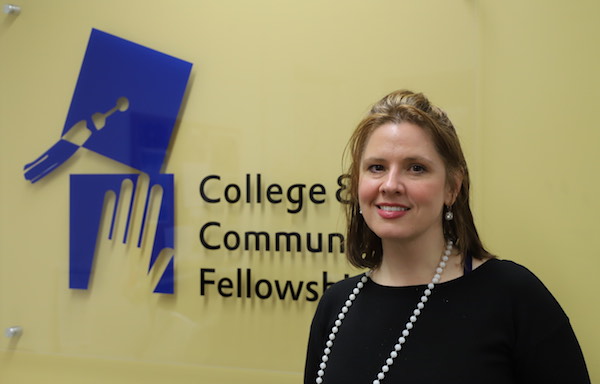
Stacy Burnett, the author (photo: College & Community Fellowship)
To the Editor:
Regarding "New York College-in-Prisons Program is Flourishing" (Dec. 3): I am proof there can be no rehabilitation in prison without education, and that restoring Tuition Assistance Program (TAP) funding for college-in-prison participants must be a top priority if New York is serious about building safer communities.
In 2013, I was released from Albion Correctional Facility with $40 and a bus ticket to a county that did not want me. After serving five years, I had spent 1,428 hours in solitary confinement, compared to just 30 hours in a college classroom – there was no funding for college at Albion for people over age 25. In 2017, I was returned to prison, and shipped to a facility that offered the Bard Prison Initiative.
This time, I spent those thousand-plus hours in classrooms with professors who demanded more of me than I thought I had to give. I was challenged, and despite my physical confinement to a few dusty acres, my world expanded. And it continues to expand. Parsing Shakespeare and Anna Karenina provided me with critical thinking and analytical skills that I apply to everyday life. Education – not prison – enables me to be productive today. I am part of a new community of achievers.
New York taxpayers have spent over a quarter million dollars to confine me – funding TAP is so small in comparison. Studies prove my education is the best insurance against another term of incarceration.
The Bard Prison Initiative turned my life around in less than a year – something that the New York State penal system could not accomplish on its own in five. It’s time the New York State Legislature continue to lead in criminal justice reform and turn on the TAP for people in prison.
Sincerely,
Stacy Burnett, a writer, formerly incarcerated Bard Prison Initiative student and current College & Community Fellowship (CCF) fellow who lives in Queens and is working alongside CCF to restore TAP funding for incarcerated students through the Turn On The Tap campaign.
***
Have an op-ed idea or submission for Gotham Gazette? Email This email address is being protected from spambots. You need JavaScript enabled to view it.
Jay Kriegel’s Unmatchable New York Ethos
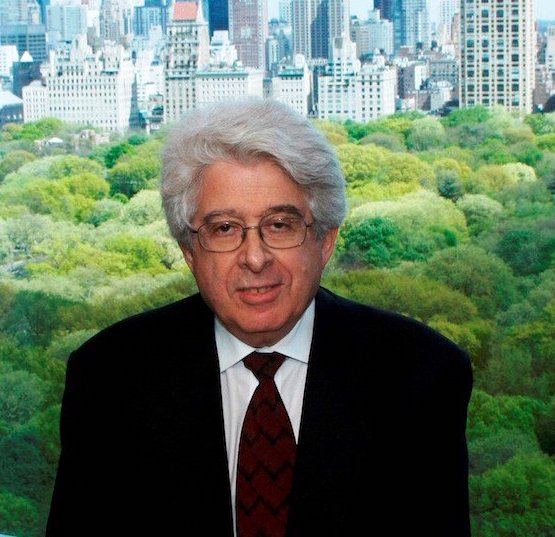
Jay Kriegel, 1940-2019 (photo via ABNY)
Jay Kriegel wasn’t a New Yorker, he was New York. In Jay our city was personified, embodied, embedded, in a being the likes of which we will ever know again.
The architecture of his hair alone—towering, iridescent, and high density—distinguished him from the mere mortals who ply our sidewalks, most of whom he knew. Walking Midtown with Jay was like being Mick Jagger’s wingman. From sales clerks to senators, he knew them all, and they all adored him. Ordering a meal with Jay was theater. By the end we knew everything about our server, where they were from, where they had studied acting, and how enamored they were, man or woman, twinkly-eyed, of Jay.
Never mind that for the sake of work we were having breakfast in the Regency surrounded by the self-important; to Jay our server held much more currency than the context, because he knew the actual backbone of New York.
Like so many of Gotham’s now-graying urbanists, I first met Jay while I was employed in the first term of the Bloomberg Administration and he was running the Olympics bid. He was our Yoda. Grouchy, mischievous, brutally honest, there was no bullshit with Jay. For all the pedigree we imported from the halls of Cambridge or Berkeley or Ithaca or Ann Arbor, it was no match for the wisdom of the streets that was Jay’s mastery.
Once he counseled that I should get my shoes shined during rainy weather to protect them, contrary to those who shined their shoes to look good on sunny days. “Rookie mistake,” the pro quipped.
Humility was Jay’s prime directive. In a city of dense egos and vainglorious masters of the universe, Jay was the master of self-effacement. It is this lesson, the hardest lesson for so many of us, that Jay exuded.
As Roy Bahat, a once Jedi apprentice, recently noted in his beautiful essay, for Jay it was about them, not you. Furthermore, this humility, if it was to be authentic, had to be anonymous—there would be no virtue-signaling for Jay. For the innumerable people he had helped, from young students of limited means to we rookies of limited wisdom, there would be no accolades or likes in return for the shelter of his wings. Humility demanded closed door, whispered telephone conversations that led to unrewarded action, as I would learn so personally.
While working with Jay, my spouse Maria and I decided we wanted to adopt from India. Many of the principals around us were skeptical—why gamble with adoption when we already had a biological son? But not Jay. He loved the idea from the outset and would follow its developments daily. Had I heard from the adoption agency? What is the condition of the orphanage? Were there doctors near? Then a magic moment arrived. An email. The agency had identified for us a beautiful three-month-old girl. A photo. Double-click. Two massive eyes pierced the screen. I’m not sure who was more in love, me, Maria, our son, or Jay.
Eight months passed when the adoption agency called: her paperwork was finally ready, it was time to fly. Days later, my heart beating like hummingbird, Avia and I met for the first time. Calamity struck when we flew to New Delhi to get a visa from the U.S. Embassy. Ironically while the Indian bureaucracy had processed her paperwork, the American bureaucracy hadn’t. Embassy staff callously explained that we couldn’t leave India for at least eight weeks, an impossible timeframe.
Panic stricken, I had one instinct: call Jay. It was 10 p.m. in New York, when I knew his long nights typically began. The consummate fixer, Jay was sleeplessly, passionately on it. Days went by until the hotel phone rang. It was the senior consular officer, politely inviting us to the embassy to speak in person.
“Mr. Chakrabarti, who are you exactly?”
“I’m an architect from New York.”
“Mr. Chakrabarti, in the last 48 hours this embassy has been inundated with emails and phone calls from around the world, from Condoleeza Rice’s office, from the Carlyle Group, from several ambassadors, from...”
I smiled silently, picturing Jay working the phone like a lightsaber. Avia and I were on a flight two days later, home before Christmas, as was the enormous stuffed Orangutan that Jay and his dear Kathryn had sent as a homecoming gift.
I am ever aware that the unconnected could never have pulled off what we did, and that this was both unfair and much the way of the world.
Jay, a man of a different generation, from a different New York, understood both conditions, understood this liminal zone between aspiration and reality. He knew that we should always fight for fairness, but we also should help whom we can when we can in this unjust, untidy world.
Jay’s New York understood humanity without binaries—to him there was good in both Jane Jacobs and Robert Moses. Much like Jay’s hair, between black and white was not the gray of compromise, but the silver of wisdom. At his knee we learned that the real dark side of the force were those who lived in a world of absolutes—those who fought against change at all costs, or those who fought for profit over everything. His is a lost ethos today, drowning as we are in the toxic, humorless rhetoric of absolutism.
For Jay the only absolute was New York itself. His desire for the success of each and every New Yorker eclipsed all else. The contagion of his wit and generosity spread to most of us fortunate enough to have been in his orbit, yet none of us can be Jay, none of us can come close. We can only aspire to embody Jay Kriegel’s undying spirit, a giant walking into the sea, taking with him a New York we can only hope to someday recover.
***
Vishaan Chakrabarti is an architect and author. On Twitter @VishaanNYCA.
***
Have an op-ed idea or submission for Gotham Gazette? Email This email address is being protected from spambots. You need JavaScript enabled to view it.
Worrisome City Budget Update Buried by Holiday and State Woes
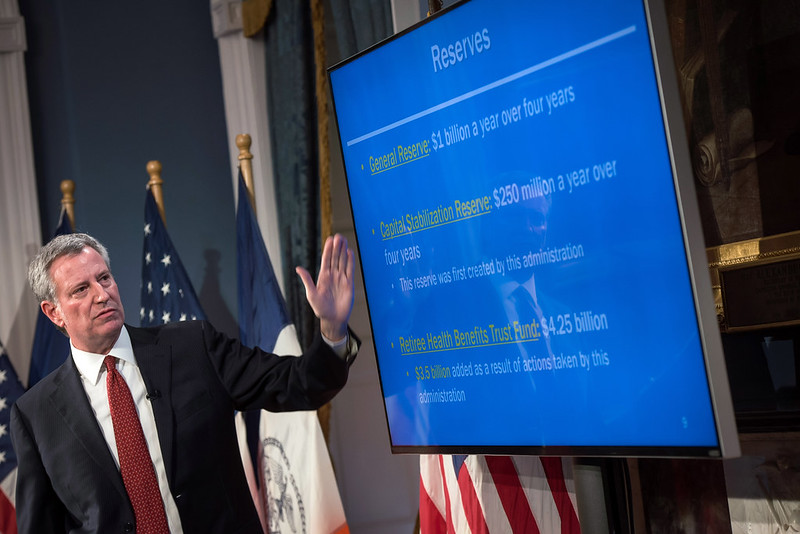
Mayor de Blasio gives a budget presentation (photo: Ed Reed/Mayoral Photo Office)
It is an axiom of media relations that when you don’t want something to get a lot of attention, you make it public at a time when few will be paying attention. So, the Friday before last week’s Thanksgiving holiday, when reporters and news consumers were getting ready to greet family, cook and/or travel, both Governor Cuomo and the Mayor de Blasio announced unsettling budget reports.
The governor released an update to the state’s four-year financial plan (required by law on October 31 but usually issued a few weeks late) and the Mayor released the required November mid-year modification to the current fiscal year (FY 2020) budget and revisions to the city’s financial plan for the subsequent three years.
This play did not work very well for the governor because the news was dramatic enough to overcome the timing of its release: due to the tremendous growth in the cost of Medicaid, the state’s operating deficit for the fiscal year that will begin on April 1, 2020 is now projected to exceed $6 billion and grow to $8.5 billion in 2023.
The mayor was more fortunate in that he did get by with very little news coverage of his budget revisions. But that doesn’t mean this information was unworthy of attention and concern. City spending in the current fiscal year is now expected to be $1.6 billion higher than was planned in the budget adopted by the City Council last June, a budget that was already $94.9 billion, or 3.1% more than the budget for the previous year (using Citizens Budget Commission’s adjusted figures).
In the course of the last six months, the mayor, often together with the Council, has announced a number of new initiatives and program expansions, for example higher wages for pre-kindergarten teachers and public defenders, criminal justice reforms (some required by state legislation), more mental health interventions. All of these efforts come at a cost, frequently including new hiring, and the cumulative impact can now be seen in the budget modification.
Headcount is up 1,148 positions in just the last six months. Current total city budgeted headcount is 334,581, growing to 336,005 in FY 2021, and 338,000 in FY 2022 and FY 2023 -- far exceeding the peak before the 2008 recession of 311,018. Not only do all these new hires mean more payroll now, but they will also go into the base for calculating the cost of city-provided pensions and health care benefits far into the future.
The mayor promises to offset much of the increased costs with savings, but most of the offsets are from interest re-estimates on debt service and reimbursements from the state and federal governments, not recurring efficiencies. Indeed, the administration’s commitment to achieving savings is waning: this November citywide savings plan is only 73% of the plans issued in November 2017 and 2018. Are there not far more ineffective or outmoded programs, procedures, and services that can be improved, streamlined, or eliminated?
It is good news that personal income and business tax revenue are projected to grow and that federal reimbursements and grants have been received to offset some of the new expenses, but neither will continue indefinitely and the possible negative impact of the severe change to the SALT deduction and newly adopted rent regulations on property values, on which much of city revenue depends, is yet to be determined.
Most worrisome is that the increased spending included in the November city budget modification is likely only a preview of even more spending growth. There is still time between now and the adoption of the final budget for the next fiscal year (due by June 30 2020) for there to be even more new initiatives added on that will need to be paid for with city funds.
In the FY 2019 budget cycle, between November 2018 and June 2019 the mayor and City Council added $2.5 billion to the annual budget. The increase over the same time period in the most recent budget cycle was $1.6 billion. If the mayor and Council speaker continue this pattern in the coming months, the FY 2021 budget could grow by another $2 billion or more by June.
With the state facing precarious times, it could well implement cuts to state-funded programs like Medicaid and school aid. Under the current circumstances, it cannot be expected that the federal government will help the state or city with budget shortfalls. To be prepared we need more reserves, more efficiencies, and an end to endless hiring.
***
Carol Kellermann was president of Citizens Budget Commission from 2008 through 2018.
***
Have an op-ed idea or submission for Gotham Gazette? Email This email address is being protected from spambots. You need JavaScript enabled to view it.
A Greenway for Queens
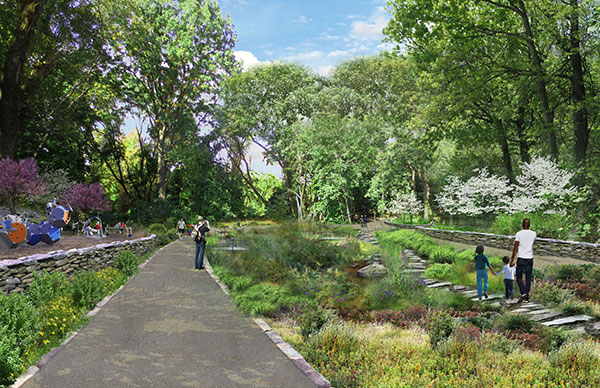
(rendering: DLANDstudio)
In the heart of Queens there is a 3.5-mile strip of abandoned railroad track that represents the promise of transformation. No train has traversed its overgrown rails since 1962. A mature forest of trees towers above the derelict tracks. Weeds and wildflowers poke up amid the trash that has been dumped there.
It is a space that could better serve some of New York City’s most diverse communities and show that every neighborhood deserves a great park and a safe place away from cars to walk, run, and cycle.
The Trust for Public Land, Friends of the QueensWay, and the Queens Chamber of Commerce are solidly behind a plan to develop this neglected swath of industrial infrastructure into an imaginative greenway with outdoor classrooms, tree-canopied walkways, picnic areas, bike paths, jogging trails, four-season landscaping, and year-round nature-based programs.
A greenway park will carve a calm, welcoming river of plants and paths through Central Queens; improve air quality; moderate increasing summer temperatures along its route; create a safe right-of way for schoolchildren; provide traffic-free pedestrian and bike routes to existing transit hubs; extend the beautiful oak forest and lively amenities into communities; and stimulate the surrounding area’s economy and businesses.
The QueensWay will be a great New York park that takes its character from the diverse communities that it ties together.
It’s time for Mayor de Blasio to say “Yes” to The QueensWay and include preliminary funding in the upcoming city capital plan. Further delay, while other boroughs see investments in greenways, is unjustified and unfair.
For decades, the 47-acre abandoned line in Queens has slipped deeper into decay as decisions about its fate were debated and delayed. But a critical evaluation of the potentials and possibilities for the rail line is in—and the evidence is clear. The MTA took a hard look at the cost and the benefits of rebuilding the railroad corridor for rail traffic and determined the prohibitive price tag for railroad restoration could exceed $9 billion, and that any transit benefit from reopening the line would be minimal at best.
That sticker shock doesn’t even factor in the additional costs and impact on the homes, businesses and commuters that would be affected. As the MTA noted but did not factor into its cost estimate, construction would take years and would close roads, sacrifice community spaces like the Forest Hills Little League facility, disrupt and slow service on existing train lines, force nearby residents to cope with an active railway just steps from their houses, evict commercial tenants beneath the viaduct, clear cut a winding stand of 60-year-old trees, and alienate at least seven acres that are designated parkland.
That finding—that we can’t justify the high cost of reconstructing the 3.5-mile corridor as a useful rail line—removed the last questions about the direction we should take. A park on the old rail line is shovel-ready and the long-unused bridges, rails, and viaducts can be adapted without major disruption to the surrounding area. The QueensWay will cost less than two percent of the cost of rail reactivation. Most important, the idea has widespread support in the community.
This is the moment to acknowledge the extraordinary gift of an open, expansive linear greenway and reclaim the desolate space as a place for people. A greenway for Queens is a celebration of resilience, of the trees and plants asserting themselves along the old rail line, of the people eager to embrace an opportunity to transform an eyesore into a dynamic resource, and of a borough whose time has come. Now is the time to make The Queensway happen.
***
Carter Strickland is New York State Director of The Trust for Public Land; Travis Terry is President of Friends of QueensWay; and Thomas J. Grech is President & CEO of the Queens Chamber of Commerce.
***
Have an op-ed idea or submission for Gotham Gazette? Email This email address is being protected from spambots. You need JavaScript enabled to view it.